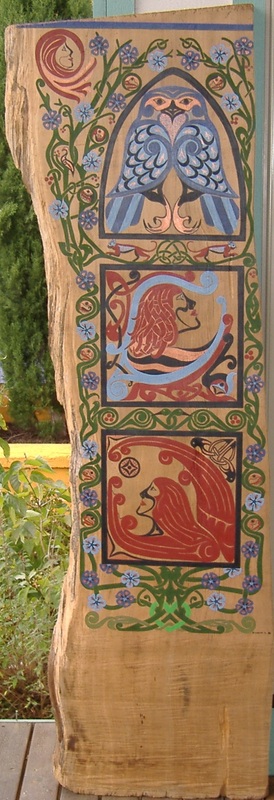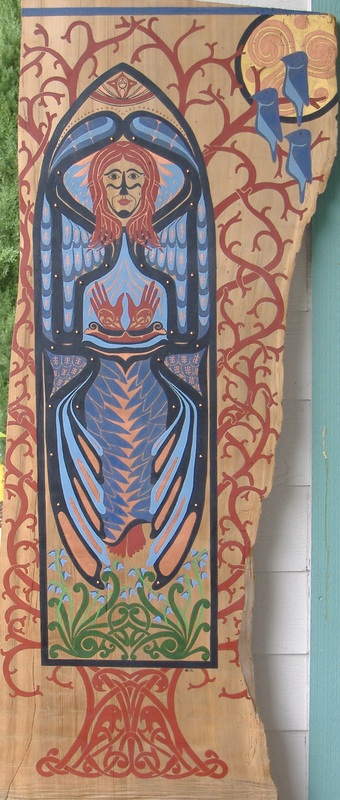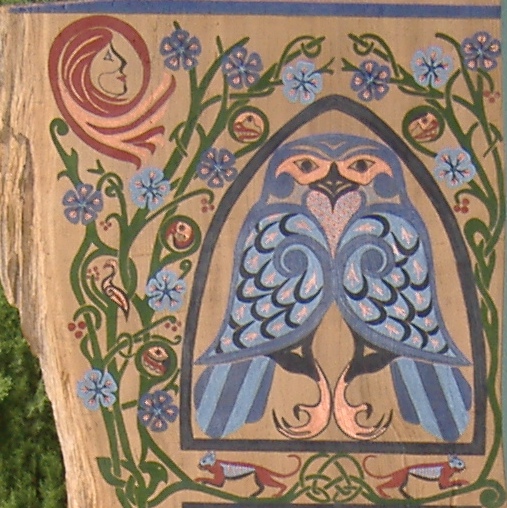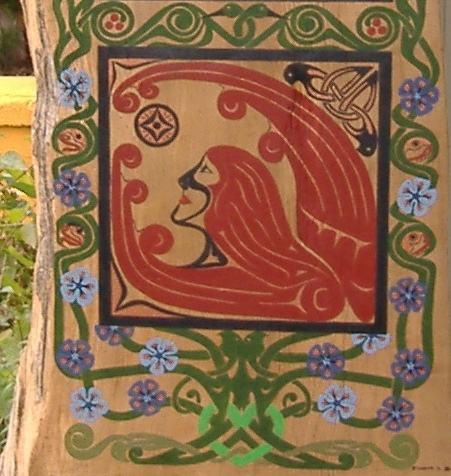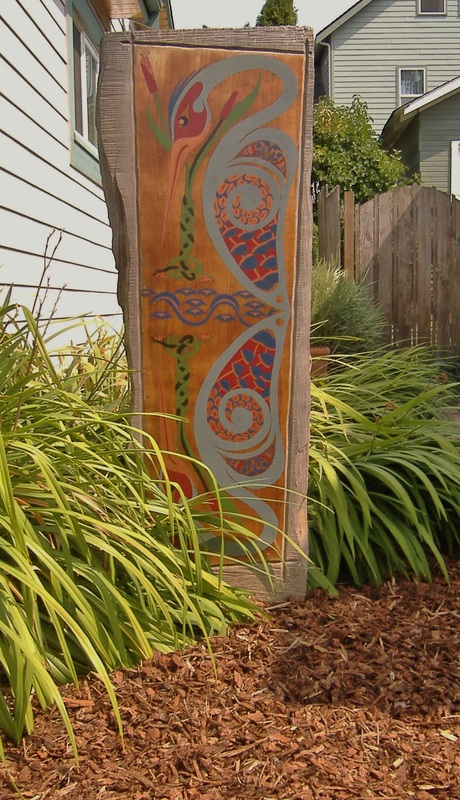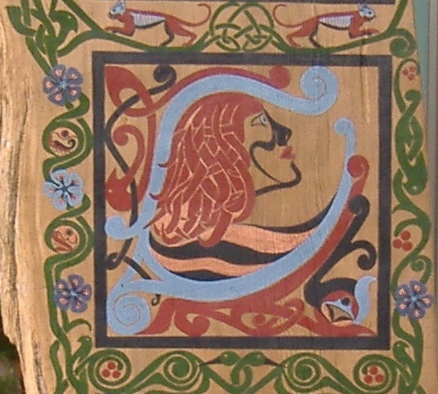WATTS CHAPEL TRIBUTE MEMORIAL
ACRYLICS ON CEDAR
(FALL 2012)
ACRYLICS ON CEDAR
(FALL 2012)
My introduction to the art of Mary Seton Watts came about as I was studying the designs of Archibald Knox. Both Knox and Watts were part of the Celtic Revival Movement and they collaborated on designs for garden pottery produced at Watts’s Compton Pottery Works in Surrey, England. However, my interest was renewed and enhanced after recently viewing Stephen Smith’s BBC Four program Art Nouveau: Sex and Sensibility (2012). In the second episode on British Art Nouveau, Smith visits the Watts Memorial Chapel in Compton and seeing the Celtic entrelac designs on both the exterior and interior lead me to study Watts further. It inspired me to paint something relating to her work and the chapel. I accessed additional information on the Watts Memorial Chapel from “Archibald Knox and Mary Seton Watts: Pioneers of ‘Modern Celtic Art’ Garden Pottery” by Veronica Franklin Gould in Stephen A. Martin’s Archibald Knox (©2001, pages 76-84) and from Rosalind P. Blakesley’s The Arts and Crafts Movement (©2006, pages 76-80). This was another opportunity to use one of the large slabs of red cedar given to me by Bill Pearl. When Bill was moving from his home in Sekiu to Port Angeles and cleaning out his woodshed, he gave me several beautiful slabs of red cedar. Bill had gotten these in the late 1970’s from a good friend and fellow teacher at Neah Bay who had since passed away. He gave them to me with the hope that I would use them well in doing my art. This is the fifth of the slabs that I have used. The others were used to paint Wolf & Beaver [1988], Mockingbird-Failte [1999], Whale Sacrifice [2002], and The Herons “Stone” [2011]. The cedar slab shows the rough saw marks used to create it and the slab’s tight, vertical grain is beautiful. This time I l smoothed both the front and the back of the slab but left the sides, still containing the bark, in the rough state. It reminds me of the beautiful furniture with the “live edges” made famous by George Nakashima. When I look at the asymmetry of the slab, it brings back memories of the ancient standing stones from the Ring of Stenness (built in 3100 BC) in Orkney, Scotland. The Hilton of Cadboll Stone on the Tarbat Peninsula in Easter Ross, Scotland, one of the most spectacular Pictish stones from the 6th to 9th centuries, was helpful in creating my design. So too was the Germanic Irminsul, and the Tree of Life symbol from a 10th century manuscript of the Reichenau School seen in The Celtic Cross by Nigel Pennick (©1997, page 59). The human faces I designed were influenced by the prints of Roy Vickers. I met him at a conference at Simon Fraser University in Burnaby, B.C. in early 1976 and watched his booth as he went to take a short break. I saw how he used tracing paper to insure symmetry in his designs and have used this method ever since. I bought an unsigned copy of his print “First Horseman of the Apocalypse” but was impressed by a half-red and half-black print of the face of Christ (“John 15:13, Hebrews 9:28”). I think these prints have sat in the back of my mind and have influenced how I design human faces today. For images of Vickers’s prints, see Hilary Stewart’s Looking at Indian Art of the Northwest Coast (©1979, page 90: “Tsimshian Woman”) and Edwin S. Hall, Jr., Margaret B. Blackman & Vincent Rickard’s Northwest Coast Indian Graphics: An Introduction to Silk Screen Prints (©1981, page 96: “John 15:13, Hebrews 9:28”, page 100: “First Horseman of the Apocalypse”, & page117: “Lacrosse Player”). I also must cite Hans van Lemmen’s Art Nouveau Tiles (©2008, front cover and page 44) for the images of a J & W Wade & Co 1901 tile showing a woman’s profile. This source was also helpful in designing my human faces. The Book of Kells was again helpful in designing the eagle seen on the back of the memorial and I was inspired by the Eagle of St. John from folio 129 verso, “The Four Evangelists”. Finally, the three birds silhouetted by the moon were inspired by Archibald Knox’s “silent birds” that he drew for the Douglas Secondary School Book of Remembrance (see page 174 in Stephen A. Martin’s Archibald Knox, ©2001). They symbolize the spirits of the dead. This piece is intended for placement in a garden as "garden art", tying it once again to Mary Seton Watts's Compton pots. I placed my Heron Stane similarly, supported by poured concrete (see photo below). The bottom 15 inches of the slab is left unpainted on either side to allow for its installation in the ground.
DIMENSIONS: HEIGHT: 68.5 inches
WIDTH: 20.75 inches
THICKNESS: 1.75 inches
This painting has been treated with Minwax Helmsman Spar Urethane to give protection from sunlight, rain & moisture, and temperature changes. The finish is clear satin. This makes it suitable for showing outdoors in a protected area.
PRICE $3,000
DIMENSIONS: HEIGHT: 68.5 inches
WIDTH: 20.75 inches
THICKNESS: 1.75 inches
This painting has been treated with Minwax Helmsman Spar Urethane to give protection from sunlight, rain & moisture, and temperature changes. The finish is clear satin. This makes it suitable for showing outdoors in a protected area.
PRICE $3,000
